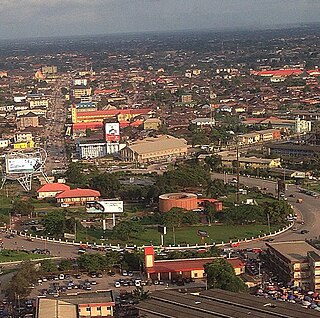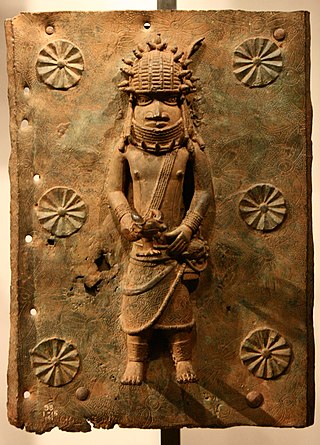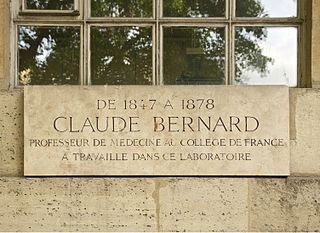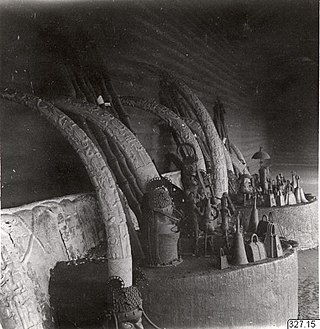
Benin City is the capital and largest city of Edo State, southern Nigeria. It is the fourth-largest city in Nigeria according to the 2006 census, after Lagos, Kano, and Ibadan. It is situated approximately 40 kilometres (25 mi) north of the Benin River and 320 kilometres (200 mi) by road east of Lagos. Benin City is the centre of Nigeria's rubber industry, and Palm oil production is also a significant industry.
The Benin Expedition of 1897 was a punitive expedition by a British force of 1,200 men under Sir Harry Rawson. It came in response to the ambush and slaughter of a 250 strong party led by British Acting Consul General James Phillips of the Niger Coast Protectorate. Rawson's troops captured Benin City, and indeed the Kingdom of Benin itself, which was eventually absorbed into colonial Nigeria. The expedition freed captives held by the Oba.

The Oba of Benin is the traditional ruler and the custodian of the culture of the Edo people and all Edoid people. The then Kingdom of Benin has continued to be mostly populated by the Edo.

The Benin Bronzes are a group of several thousand metal plaques and sculptures that decorated the royal palace of the Kingdom of Benin, in what is now Edo State, Nigeria. Collectively, the objects form the best examples of Benin art and were created from the fourteenth century by artists of the Edo people. The plaques, which in the Edo language are called Ama, depict scenes or represent themes in the history of the kingdom. Apart from the plaques, other sculptures in brass or bronze include portrait heads, jewelry, and smaller pieces.

A commemorative plaque, or simply plaque, or in other places referred to as a historical marker, historic marker, or historic plaque, is a plate of metal, ceramic, stone, wood, or other material, typically attached to a wall, stone, or other vertical surface, and bearing text or an image in relief, or both, to commemorate one or more persons, an event, a former use of the place, or some other thing. Many modern plaques and markers are used to associate the location where the plaque or marker is installed with the person, event, or item commemorated as a place worthy of visit. A monumental plaque or tablet commemorating a deceased person or persons, can be a simple form of church monument. Most modern plaques affixed in this way are commemorative of something, but this is not always the case, and there are purely religious plaques, or those signifying ownership or affiliation of some sort. A plaquette is a small plaque, but in English, unlike many European languages, the term is not typically used for outdoor plaques fixed to walls.

Oba Ovonramwen Nogbaisi, also called Overami, was the thirty-fifth Ọba of the Kingdom of Benin reigning from c. 1888 AD – c. 1897 AD, up until the British punitive expedition.

Esigie, originally known as Osawe, was the son of Oba Ozolua, who reigned in the late 15th century, and his second wife, Queen Idia. He was the sixteenth Oba who ruled the medieval Benin Kingdom, now Benin City, Edo State, Nigeria from c. 1504 – c. 1550. Works of art commissioned by Esigie are held in prominent museums including the Metropolitan Museum of Art and the British Museum.

Idia was the mother of Esigie, who reigned as Oba (king) of the Edo people from 1504 to 1550. Historians do know that Idia was alive during the Idah war because she played a role that led to a great Benin victory. It has been argued that Idia, therefore, was the true power behind the throne of her son. She played a significant role in the rise and reign of her son, being described as a great warrior who fought relentlessly before and during her son's reign as the Oba (king) of the Edo people. Queen Idia was instrumental in securing the title of Oba for her son Esigie following the death of his father Oba Ozolua. To that end, she raised an army to fight off his brother Arhuaran who was supposed to be the Oba by right and tradition but was subsequently defeated in battle. Esigie’s mother became the 17th Oba of Benin.

Benin art is the art from the Kingdom of Benin or Edo Empire (1440–1897), a pre-colonial African state located in what is now known as the Southern region of Nigeria. Primarily made of cast bronze and carved ivory, Benin art was produced mainly for the court of the Oba of Benin – a divine ruler for whom the craftsmen produced a range of ceremonially significant objects. The full complexity of these works can be appreciated through the awareness and consideration of two complementary cultural perceptions of the art of Benin: the Western appreciation of them primarily as works of art, and their understanding in Benin as historical documents and as mnemonic devices to reconstruct history, or as ritual objects. This original significance is of great importance in Benin.

The Kingdom of Benin, also known as the Edo Kingdom or Benin Kingdom, is a kingdom within what is now southern Nigeria. It has no historical relation to the modern republic of Benin, which was known as Dahomey from the 17th century until 1975. The Kingdom of Benin's capital was Edo, now known as Benin City in Edo State, Nigeria. The Benin Kingdom was "one of the oldest and most developed states in the coastal hinterland of West Africa". It grew out of the previous Edo Kingdom of Igodomigodo around the 11th century AD, and lasted until it was annexed by the British Empire in 1897.

Ọmọ n'Ọba n'Ẹdo Uku Akpọlọkpọlọ, Akenzua II was the thirty-seventh Oba of Benin reigning from 1933 until his death in 1978.

Benin ancestral altars are adorned with some of the finest examples of art from the Benin Kingdom of south-central Nigeria.
Chief Agho Obaseki was a paramount Chief in the Benin Empire from 1898 to 1914, and then Iyase of Benin from 1914 until his death in 1920.

Aiguobasinwin Ovonramwen, Eweka II was the thirty-sixth Oba of Benin, reigning from 1914 to 1933.

Okukor is the name given to a bronze statue of a cock from West Africa, held by Jesus College, Cambridge, from 1905 to 2021. One of the Benin bronzes, it was taken from the Kingdom of Benin during the Benin Expedition of 1897, a punitive expedition dispatched to punish the Oba of Benin after a Royal Niger Company delegation was ambushed and killed. It became controversial in 2016 as an example of looted art, with demands that the statue be repatriated back to Nigeria. It was transferred to Ewuare II, Oba of Benin, and Nigeria's National Commission for Museums and Monuments by Jesus College in 2021.

The Benin Dialogue Group is a multi-lateral international collaborative working group that brings together delegates from Western museums with representatives of the Nigerian Government, the Royal Court of Benin, and the Nigerian National Commission for Museums and Monuments. Its aims are cooperation between museums possessing Nigerian cultural heritage and the creation of a permanent display in Benin City, in particular the Benin Bronzes.
The Benin Moat, also known as the Benin Iya, or Walls of Benin, are a series of massive earthworks encircling Benin City in Nigeria's Edo State. These moats have deep historical roots, with evidence suggesting their existence before the establishment of the Oba monarchy. Construction began around 800 AD and continued until 1460 AD, involving large-scale manual labour and the repurposing of earth from the inner ditch to build the outer berm. Some traditional sources claim that these earthworks spanned approximately 16,000 kilometres (9,900 mi), enclosing about 6,500 square kilometres (2,500 sq mi) of land, but very little remains today.

Benin City Ring Road also referred to as Kings Square or Oba Ovonramwen Square is a circular road in Benin City, the capital of Edo State, Nigeria. It spans approximately 25 kilometers and has been a vital component of the city's transportation network since its establishment in 1976.

Benin Altar Tusks are ivory artefacts from the Benin Kingdom in present-day Benin City, Edo State, Nigeria. These tusks date back to the 16th century and measure approximately 61 inches (1,500 mm) in height, 5.2 inches (130 mm) in width, 4.7 inches (120 mm) in depth, and weighing 25 kilograms (55 lb) according to a sample at the British Museum. The tusks feature carved royal figures in traditional regalia, depicting scenes of power, ritual, and at times, conflict.

The Akure–Benin War in 1818 was a conflict between the Benin Kingdom and the Akure Kingdom in what is now Nigeria. The origins of this conflict can be traced to the complex history of the region, with Akure being a place of ancient settlements, some dating back to the early Ife kingdom. The Akure Kingdom emerged when these communities were consolidated under the rule of Prince Omoremilekun, who descended from Oduduwa, a revered figure in Yoruba history. Historically, the relationship between Benin and Akure had been marked by peace and mutual respect due to shared cultural heritage and ancestry.
















